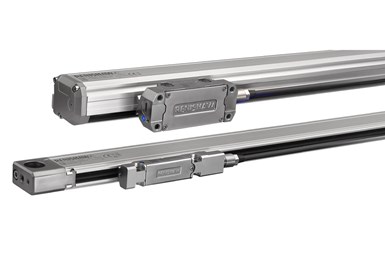Renishaw Debuts High-Durability Fortis Absolute Encoders
Renishaw designed its non-contact Fortis encoders for maximum repeatability and durability, with a vibration-resistance rating of up to 30 g.
Share






Renishaw recommends its Fortis enclosed linear absolute encoder series for use in harsh environments, such as around machine tools.
The Fortis design uses Renishaw’s Resolute encoder technology. It features an extruded enclosure with longitudinally attached interlocking lip seals and sealed end caps. The readhead body joins a sealed optical unit by a blade, which travels through the lip seals along the length of the encoder. Linear-axis movement causes the readhead and optics to traverse the encoder’s absolute scale (which is fixed to the inside of the enclosure) without mechanical contact.
Customers can choose from two different extrusion profiles to suit their space requirements. The Fortis-S linear encoder is the standard-sized encoder, available with measuring lengths from 140 mm to 3040 mm. The Fortis-N encoder, available with measuring lengths from 70 mm to 2040 mm, features a narrower cross-section extrusion and a more-compact readhead to enable installations in confined spaces.
“The new Fortis … delivers superior repeatability, reduced hysteresis and improved measurement performance due to an innovative non-contact mechanical design that doesn’t require a mechanical guidance carriage,” says Ian Eldred, Fortis principal mechanical engineer.
Renishaw designed the Fortis absolute encoder series to resist a wide range of mechanical shock and vibration effects. All Fortis-S encoders, and Fortis-N encoders when installed with mounting spars, have up to 30 g of vibration resistance. The company says this ensures dependable metrology even in harsh environments and under demanding motion-control applications.
In addition to its extruded enclosure, a further level of sealing protects Fortis encoders against contamination: the readhead optical unit (which runs inside the enclosure) is itself sealed to IP67 to prevent contamination from liquids, swarf and other debris. Improved sealing of the FORTiS encoder enclosure also reduces air leakage from the air purge system, resulting in lower operating costs and greater system longevity.
Related Content
-
How to Evaluate Measurement Uncertainty
Manufacturing and measurement are closely coupled. An important consideration for the use of measurement results is the associated measurement uncertainty. This article describes common metrology terms and provides an example uncertainty analysis.
-
Ballbar Testing Benefits Low-Volume Manufacturing
Thanks to ballbar testing with a Renishaw QC20-W, the Autodesk Technology Centers now have more confidence in their machine tools.
-
6 Machine Shop Essentials to Stay Competitive
If you want to streamline production and be competitive in the industry, you will need far more than a standard three-axis CNC mill or two-axis CNC lathe and a few measuring tools.



















.png;maxWidth=300;quality=90)




